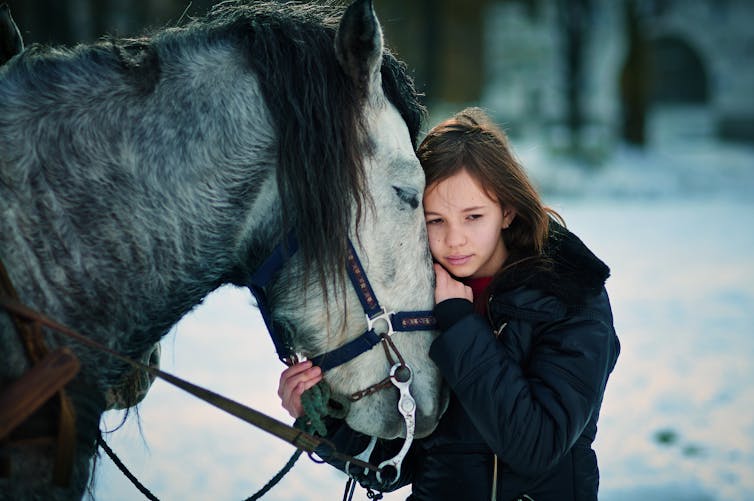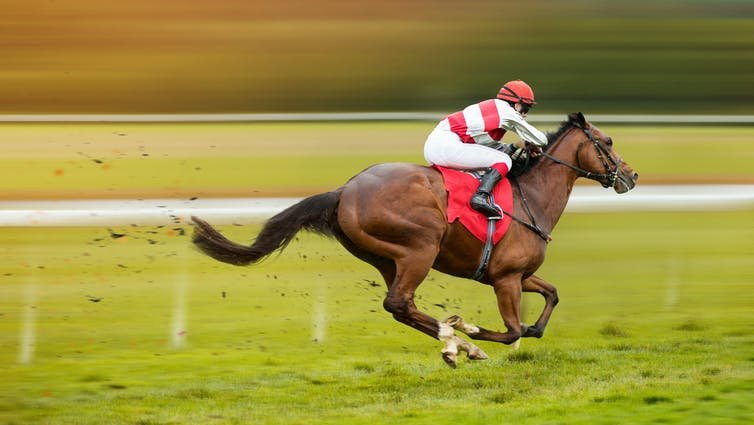It’s hard to ignore the power and beauty of a horse when it runs at full throttle or jumps over a massive hurdle.
This much loved and gentle animal is a spectacular athlete, capable of running world record speeds of almost 44 miles per hour and gravity-defying leaps as high as 2.47 metres.
They have impressive stamina too – some breeds, such as Arabians, are able to cover up to 100 miles in a single day during endurance competitions.
These are astounding feats, made all the more amazing when you consider that they weigh from 400-800kg.
Compared to other similarly sized mammals, horses have a superior ability to use oxygen – their aerobic capacity is around two and half times that of cattle, and this is a large part of what gives equines their athletic edge.
It is attributed to many aspects of their biology, including their large lungs and a notably higher number of red blood cells to maximise the transport of oxygen around the body.
Studies have also found a link between their heart size and performance in races with jumps – with one of the world’s most famous and successful racehorses, Secretariat, reported to have a heart weighing a whopping ten kilograms.
Supreme speed and agility
Horses became an evolutionarily distinct species from “early-equids” – who inhabited forests eating fruit and foliage – around four million years ago, when they moved out onto the open plains of North America, where there was abundant grass to eat. They became grazing specialists, but with this change also came fast moving predators and nowhere to hide. That’s why they evolved such incredible adaptations for speed and agility.
Humans first started to harness this natural ability around 3,500 BC in Ukraine – and there can be no doubt that selective breeding has further influenced equine athleticism. We’ve made domestic horses larger and lighter with genetic adaptations for speed in comparison to their wild ancestors.
For example, today’s thoroughbred racehorses have been bred to have a high prevalence of a “speed gene” known as myostatin, which has been directly linked to their impressive ability to sprint. The gene promotes muscle growth, which explains why short distance racehorses are often more muscular in their appearance than horses that race over longer distances.
And of course, horses are not just supreme racers. They are also able to jump over obstacles up to twice their own height.
To help them achieve these jumping feats, their four limbs are each home to a network of tendons and ligaments that act together as a spring. One particular tendon in the equine limb, known for its key role in their athletic endeavours, has exceptional elasticity and strength. This allows it to withstand extreme forces, such as those experienced during a high speed gallop and the takeoff for high fences – and it also acts as a powerful recoil on landing from those great heights.
Lukas Godja/shutterstock
Like human athletes, horses can be exposed to injury during equine sport – so the question of whether it is ethical to involve them remains. Thankfully, research in this field has expanded hugely over the past ten years, with studies in a variety of equine sports, including showjumping and racing, working towards ways of reducing the risk of injury (and even worse) for the horses, such as new training strategies and use of safer track or jumping surfaces.
Inside the horse mind
Horses are sentient beings, with psychological and behavioural needs.
They like to be free to move and interact with other horses as part of a complex social group, and to have nearly constant access to grass or hay to eat.
Read more:
Why it’s so hard to unravel the mysterious origins of domestic horses
And they are highly sensitive animals too, able to interpret our emotional responses and learn about a person from watching them interact with another horse. These equine emotional skills may be part of how we are able to achieve sporting greatness together – but it also emphasises the need to take care of their psychological wellbeing.

Ruslan 1980/shutterstock
Competing can impact on the horse’s level of stress. It can make them excited, or anxious, depending on their temperament – but if they’re trained humanely, and carefully conditioned to their workload and the competitive environment, then their working lives can be enriching for them.
It is of course unlikely that the horses themselves have any concept of competing or winning. That requires self-awareness and ego – two things that are highly tuned in humans, but unlikely to be present in horses as their brains have not evolved to develop the higher functions that create this awareness.
Racehorses run fast because they’ve been primed by evolution to run if everyone else runs; any ancestor who didn’t show that automatic flight response didn’t last long on the open grass plains. And showjumping horses float over enormous fences because they’ve been trained to do so. But as long as the training was humane, then they might well have learnt to find it rewarding.
In truth, we’ll never know for sure why horses are willing to work so closely with humans. There is nothing natural about carrying us on their backs and travelling the world from competition to competition – and yet they do. What is clear is that they are a remarkably cooperative and gentle species, so we owe it to them to ensure the future of equine sports is ethical and sustainable.
![]()
Dr Heather Cameron-Whytock has worked on projects funded by the Fédération Equestre Internationale and on projects where the study data was provided by the Fédération Equestre Internationale or British Eventing.
Carrie Ijichi has received funding from The Horse Trust.











